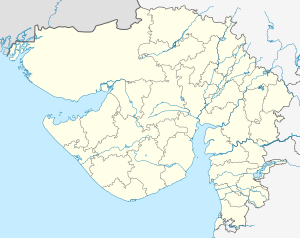Dariya Khan's Tomb
| Dariya Khan's Tomb | |
|---|---|
| Religion | |
| Affiliation | Islam |
| Status | Active |
| Location | |
| Location | Ahmedabad |
| Municipality | Ahmedabad Municipal Corporation |
| State | Gujarat |
| Geographic coordinates | 23°03′10″N 72°35′13″E / 23.052725°N 72.586809°ECoordinates: 23°03′10″N 72°35′13″E / 23.052725°N 72.586809°E |
| Architecture | |
| Type | Tomb |
| Style | Islamic architecture |
| Funded by | Dariya Khan |
| Completed | 1453 |
| Dome(s) | 17 |
| Materials | Baked bricks |
Dariya Khan's Tomb or Darya Khan's Dome or Ghummat is a medieval brick tomb in Shahibaug, Ahmedabad, India.
History and architecture[edit]
The tomb of Dariya Khan was built in 1453 during his lifetime. He was a talented minister and advisor of Mahmud Begada. The tomb, the largest in Gujarat, is of brick with nine feet thick wall unlike other tombs in Ahmedabad which are made of stones. The tomb is made of the true arches and domes which create a cavernous interior as in Turko-Persian Islamic architecture. There is a large central dome surrounded by sixteen smaller domes and there are five entrances on each of the four sides of the structure. The interior houses the cenotaph surrounded by the arcaded verandah.[1][2][3] The site is encroached upon now.[4]
References[edit]
- ↑ Gazetteer of the Bombay Presidency: Ahmedabad. Government Central Press. 1879. p. 284.
- ↑ "AHMEDABADS OTHER ROZAS". Times of India Publications. 25 February 2011. Retrieved 7 December 2014.
- ↑ Sir H. A. R. Gibb (1954). The Encyclopaedia of Islam. Brill Archive. p. 295. GGKEY:9ZS5X6XZAXR.
- ↑ "PEARLS OF PAST: Need Some Elbow Room". The Times of India. 25 November 2011. Archived from the original on 13 December 2014. Retrieved 7 December 2014.
- This article includes public domain text from Gazetteer of the Bombay Presidency: Ahmedabad. Government Central Press. 1879. p. 284.


